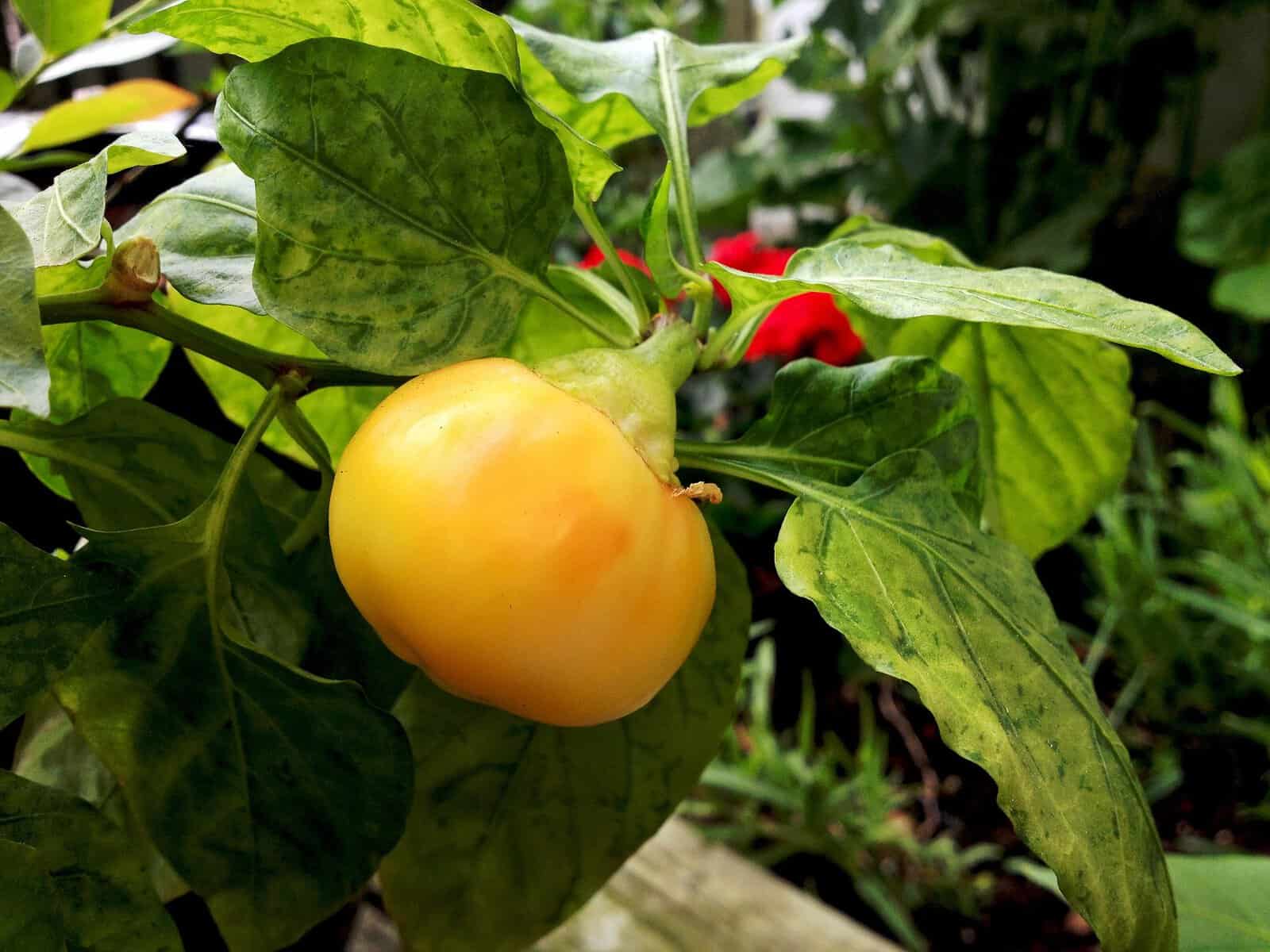Guide to Alma Paprika Peppers: From Seed to Table
Alma Paprika Peppers are a unique and flavorful variety of pepper with roots in Hungary. Known for their mild heat and sweet taste, these peppers are a staple in many Hungarian dishes and are prized for their versatility in the kitchen. In this guide, I’ll walk you through everything you need to know about Alma Paprika Peppers, from growing them in your garden to incorporating them into your cooking.
Facts about Alma Paprika
Alma Paprika
| Heat level: | Mild | |
| SHU: | 2,000 - 3,000 | |
| Classification: | Capsicum annuum | |
| Origin: | Europe | |
| Flavor: | Sweet |
What Are Alma Paprika Peppers?
Alma Paprika Peppers are a mild pepper variety, originating from Hungary, that belong to the species Capsicum annuum. These peppers are known for their round, apple-like shape and their vibrant color transition as they ripen—from creamy white to orange, and finally to a deep red. The name “Alma” means ‘apple’ in Hungarian, a nod to their shape.
With a Scoville Heat Unit (SHU) rating between 2,000 and 3,000, Alma Paprika Peppers offer a mild heat that is balanced by a sweet flavor. They are a popular ingredient in Hungarian cuisine and are often used fresh, dried, or ground into paprika powder.
Alma Paprika Vs Paprika Powder: Understanding the Difference
While Alma Paprika Peppers are a specific type of pepper, paprika powder can be made from various types of peppers. Paprika powder’s flavor can range from sweet to pungent, depending on the type of peppers used and how they are processed. Alma Paprika Peppers, when dried and ground, produce a paprika powder that is milder and sweeter compared to the more generic varieties you might find in stores.
Using fresh Alma Paprika Peppers in your cooking will give your dishes a different texture and flavor compared to using paprika powder. Fresh peppers offer a juicy, crunchy bite, while the powder provides a concentrated burst of flavor. Both have their place in the kitchen, but if you’re aiming for an authentic Hungarian taste, using Alma Paprika Peppers is the way to go.
Growing Alma Paprika: From Seed to Harvest
Growing Alma Paprika Peppers in your garden can be a rewarding experience. These peppers thrive in warm climates and prefer well-draining, nutrient-rich soil with a pH level between 6.0 and 7.5. They do best in regions with long, warm growing seasons, typically in USDA Hardiness Zones 5-11.
Starting from Seed
To start Alma Paprika Peppers from seed, begin by sowing the seeds indoors about 6 to 8 weeks before the last expected frost in your area. The seeds typically take 14 to 21 days to germinate. Keep the soil temperature between 70 and 90°F to encourage successful germination.
Once the danger of frost has passed and the soil has warmed, you can transplant the seedlings outdoors. Space the plants about 18 to 24 inches apart to allow them room to grow. These plants are relatively compact, growing to a height of 24 to 36 inches, but they can spread out, so giving them enough space is crucial.
Caring for Your Plants
Alma Paprika Peppers require consistent care to thrive. Water the plants regularly, keeping the soil evenly moist but not waterlogged. Mulching around the base of the plants can help retain moisture and suppress weeds.
Fertilize the plants every few weeks with a balanced fertilizer to ensure they receive the nutrients they need. Pay attention to any signs of nutrient deficiencies, such as yellowing leaves, and adjust your fertilization schedule accordingly.
Pruning and staking may be necessary as the plants grow, especially if they start to get top-heavy with fruit. Pruning helps improve airflow around the plants, reducing the risk of disease, and staking provides support to prevent the plants from toppling over.
Pests and Diseases
Like all plants, Alma Paprika Peppers can be susceptible to pests and diseases. Common pests include aphids, spider mites, and pepper maggots. Regularly inspect your plants for signs of infestation, such as discolored or misshapen leaves, and treat them promptly with insecticidal soap or other appropriate treatments.
Diseases such as bacterial spot, powdery mildew, and root rot can also affect pepper plants. Ensuring good air circulation, avoiding overhead watering, and rotating your crops each year can help prevent these issues.
Harvesting
Alma Paprika Peppers can be harvested at various stages of ripeness, depending on your preference. If you prefer a sweeter flavor, wait until the peppers turn red. For a milder taste, harvest them when they are still creamy white or orange.
To harvest, simply cut the peppers from the plant with a sharp knife or scissors, leaving a small portion of the stem attached. This method reduces the risk of damaging the plant.
Are Alma Paprika Peppers Hot?
Alma Paprika Peppers are known for their mild heat, with a Scoville Heat Unit (SHU) rating of 2,000 to 3,000. This makes them much milder than many other peppers, such as jalapeños, which can range from 2,500 to 8,000 SHU.
The mild heat of Alma Paprika Peppers adds a gentle warmth to dishes without overwhelming the other flavors. If you find the heat too intense, you can balance it with creamy ingredients like sour cream or cheese, which help to cool down the spiciness while still allowing you to enjoy the pepper’s unique flavor.
Cooking with Alma Paprika Peppers
Alma Paprika Peppers are incredibly versatile in the kitchen. Their sweet, mild flavor pairs well with a variety of dishes, and they can be used fresh, dried, or ground into powder. Here are a few ways to incorporate these peppers into your cooking:
- Hungarian Goulash: Alma Paprika Peppers add sweetness and a mild kick to this classic dish. Whether you use them fresh or dried, they’ll enhance the flavor and color of the goulash.
- Stuffed Peppers: Hollow out the Alma Paprika Peppers and stuff them with a mixture of ground meat, rice, and spices. The sweet flesh of the peppers complements the savory filling, making for a satisfying meal.
- Pepper Salsa: Combine chopped Alma Paprika Peppers with tomatoes, onions, cilantro, and lime juice for a fresh and flavorful salsa. The mild heat of the peppers adds just the right amount of kick.
- Roasted Pepper Soup: Roasting the peppers brings out their natural sweetness. Blend them into a creamy soup for a comforting dish that highlights the flavor of the peppers.
Pepper Jelly: Use Alma Paprika Peppers to make a sweet and mildly spicy jelly. It’s perfect for spreading on toast or using as a glaze for meats.
Storing and Preserving Alma Paprika Peppers
If you have an abundance of Alma Paprika Peppers, there are several ways to preserve them for later use.
- Refrigeration: Store fresh peppers in the crisper drawer of your refrigerator. They should last for up to a week.
- Freezing: To freeze the peppers, wash and dry them thoroughly, then remove the seeds. Place the peppers in airtight containers or freezer bags. They will keep for 6 to 8 months.
- Drying: Drying the peppers is a traditional method that allows you to store them for long periods. Once dried, the peppers can be ground into powder or used whole in cooking. To dry them, cut the peppers in half, remove the seeds, and lay them on a baking sheet. Dry them in the oven at a low temperature until they become crisp. Once dried, store them in an airtight container.
Alma Paprika Peppers are a valuable addition to any garden and kitchen. Their mild heat and sweet flavor make them a versatile ingredient in a variety of dishes, from traditional Hungarian goulash to spicy pepper jelly. By following the proper steps to grow, care for, and preserve these peppers, you can enjoy their unique flavor throughout the year.
Share your own experiences with Alma Paprika Peppers in the comments below!
Main image credit: Chrissie Sternschnuppe, shared under a CC BY-SA 2.0 license.

